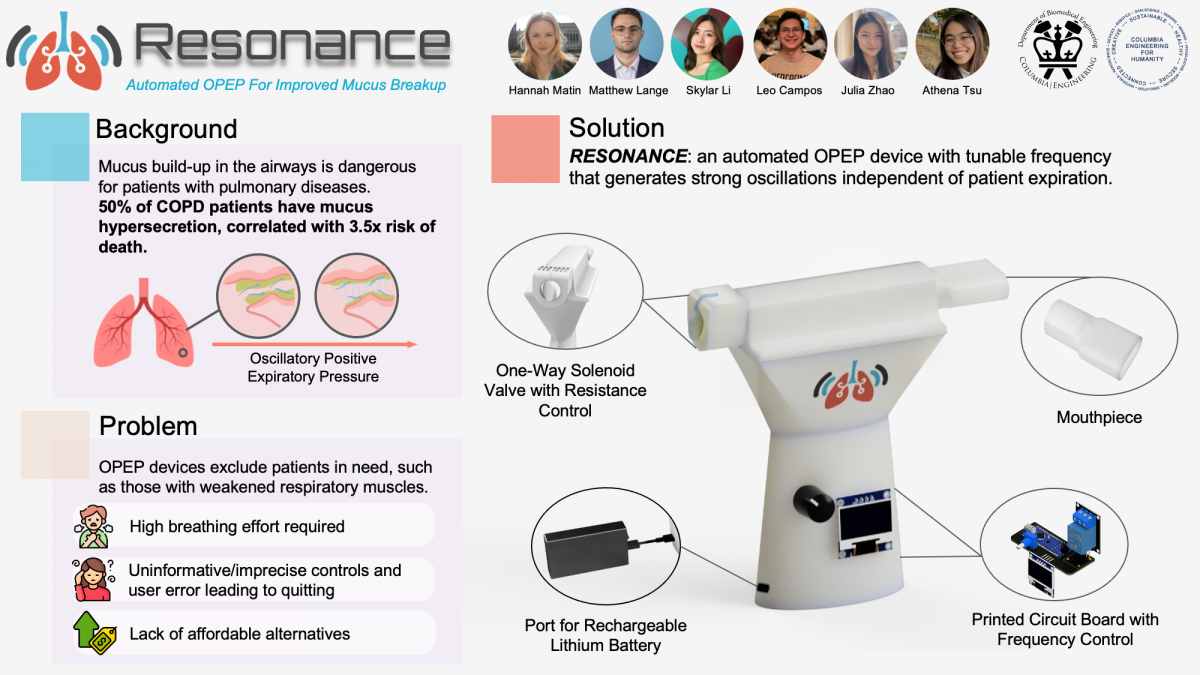Outstanding BME Students Honored – 2023
Following a month of graduation celebrations, presentations, and commencement ceremonies, the Columbia BME Department has many outstanding students to honor and recognize. All our photos from the 2023 commencement week can be found here.
Elías Tzoc-Pacheco and Jose Pomarino Nima: Claire S. and Robert E. Reiss Prize
This award is given by Robert E. Reiss, B.S. '66, and his wife, Claire S. Reiss, to the graduating senior(s) in biomedical engineering judged by the faculty of the program as most likely to contribute substantially to the field.
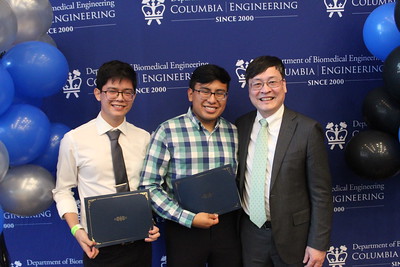
Julia Zhao: Richard Skalak Memorial Prize and 2023 Columbia Engineering Salutatorian
The Richard Skalak Memorial Prize was founded in recognition of the pioneering contributions of Richard Skalak to the development of the biomedical engineering program at Columbia University. Dr. Skalak was an inspirational teacher and scholar who taught students and colleagues to appreciate the value of broad interactions between engineering and medicine, particularly in the fields of cardiovascular mechanics, tissue engineering, and orthopedics. The Richard Skalak Memorial Prize is awarded annually to a senior biomedical engineering student who exemplifies the qualities of outstanding engineering scholarship and breadth of scientific curiosity that form the basis for lifelong learning and discovery.
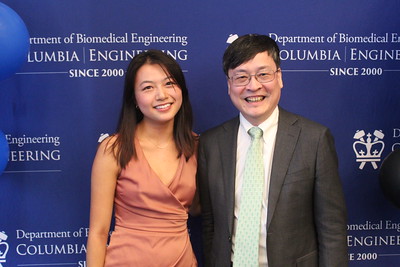
Stephen Lee and Naveed Tavakol: Yuen-huo Hung and Chao-chin Huang Award in Biomedical Engineering
Given to graduate doctoral students who have demonstrated potential for making significant contributions to the fields of biomedical engineering and public health, and for serving as ambassadors of biomedical engineering.
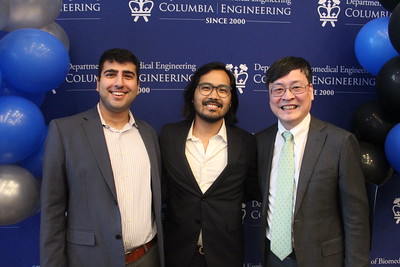
Ji Xiang and Jessica (Lucas) Wang: Outstanding Achievement Award in Biomedical Engineering Master’s Studies
Given to a Master of Science (MS) student(s) in biomedical engineering who best exhibits academic excellence, visionary leadership, and outstanding promise for the future of innovation and engineering in medicine.
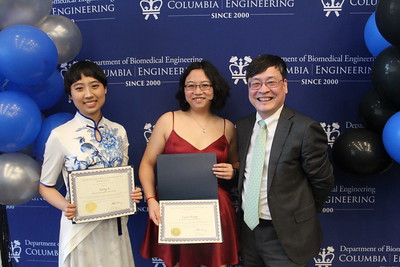
Elías Tzoc-Pacheco: 2023 George Vincent Wendell Memorial Award
The George Wendell Memorial Medal was established in 1924 by the alumni and faculty friends of the late Professor George Vincent Wendell to honor and perpetuate his memory. Each year, the SEAS faculty nominate one student from each department who they believe best exemplifies his ideals of character, scholarship, and service. The nominees are then presented to members of the SEAS senior class, who vote to determine the winner.
Athena Pagon: Leadership and Excellence Award: Community Building
Recipients of this award have worked to create, establish, or strengthen a particular community at Columbia. This could be accomplished through but is not limited to: relationship building, programming, shared goals or purpose, or creating a vision for the future.
Daniel Garcia: Leadership and Excellence Award: Principled Action
This award recognizes students who have demonstrated ethical decision-making and sound moral judgment, as well as fostering and encouraging similar actions from others.
Elvin Canseco: Leadership and Excellence Award: Columbia Spirit
Recipients of this award capture and display the best of Columbia spirit. This includes the essence of 'school spirit' and pride as a dedicated member of our community, as well as leaders and groups that contribute to local, regional, and national recognition for sports, performance, cultural and arts activities, and academic competition.
Lori Luo: Leadership and Excellence Award: Health and Wellness
Recipients of this award best exemplify the spirit of caring for and about the members of our vast and diverse community. A special focus is placed on the individual/group’s ability to establish an example for a healthy balance of responsibilities, duties, and activities through their own leadership.
Ayi Benjamin Agboglo, Kevin Hoffer-Hawlik, Elaine Nagahara, Howard Nicholson III, Christia Victoriano, Mathini Vaikunthan, and Erika Mai Kusaka: NSF GRFP and Honorable Mentions
The NSF Graduate Research Fellowship Program (GRFP) recognizes and supports outstanding graduate students who have demonstrated the potential to be high-achieving scientists and engineers early in their careers. Applicants must be pursuing full-time research-based master’s and doctoral degrees in science, technology, engineering, and mathematics (STEM) or in STEM education at accredited US institutions.
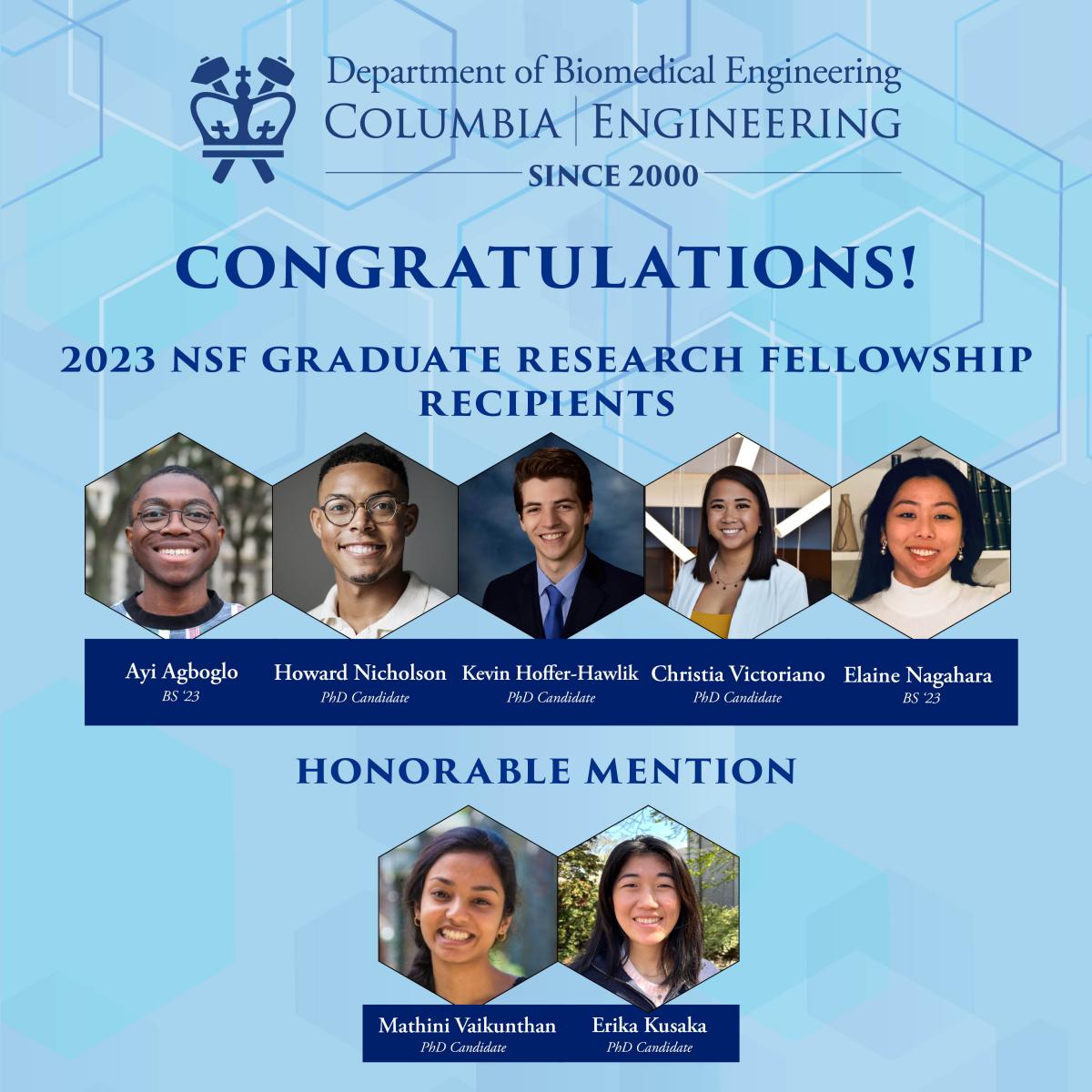
See our past winners HERE.
BME SENIOR DESIGN AWARDS
InCerv: 1st Place, BME 2023 Senior Design Award
Design Team Members: Griffin Daly, Johanna Jackson, Sopho Kevlishvili, Jose Pomarino Nima, Carly Rivera
Cervical dilation is used in Obstetrics-Gynecology procedures from family planning to oncology. Roughly 80 million gynecological procedures require cervical dilation for instruments such as IUD inserters, cameras, or catheters to pass through the cervix into the uterus for the deployment of medicines, biopsies, diagnostic tests, and treatments. The current dilation process involves repeatedly sliding metal dilators in and out of the endocervical canal, which results in lengthy procedures and pain due to friction. It can also lead to the creation of false passages in the cervical tissue resulting in bleeding, cervical laceration, and uterine perforation. Therefore, we need a way to atraumatically dilate the cervix for uterine procedures. Atraumatic dilation does not have the possibility of piercing cervical tissue or injuring the smooth muscle. InCerv is a cervical dilator that consists of a compliant, biocompatible balloon, connected to a graduated syringe filled with an incompressible fluid. As the syringe is depressed, it injects a controllable volume of fluid into the compliant balloon, causing it to expand. Due to the incompressibility of the injected fluid, the diameter and rate of expansion of the balloon can be controlled by the rate of depression of the syringe. InCerv consists of a single insertion and can achieve dilation from anywhere from 1 mm to 18 mm and uses concentric expansion of the cervix to lessen pain associated with cervical dilation.
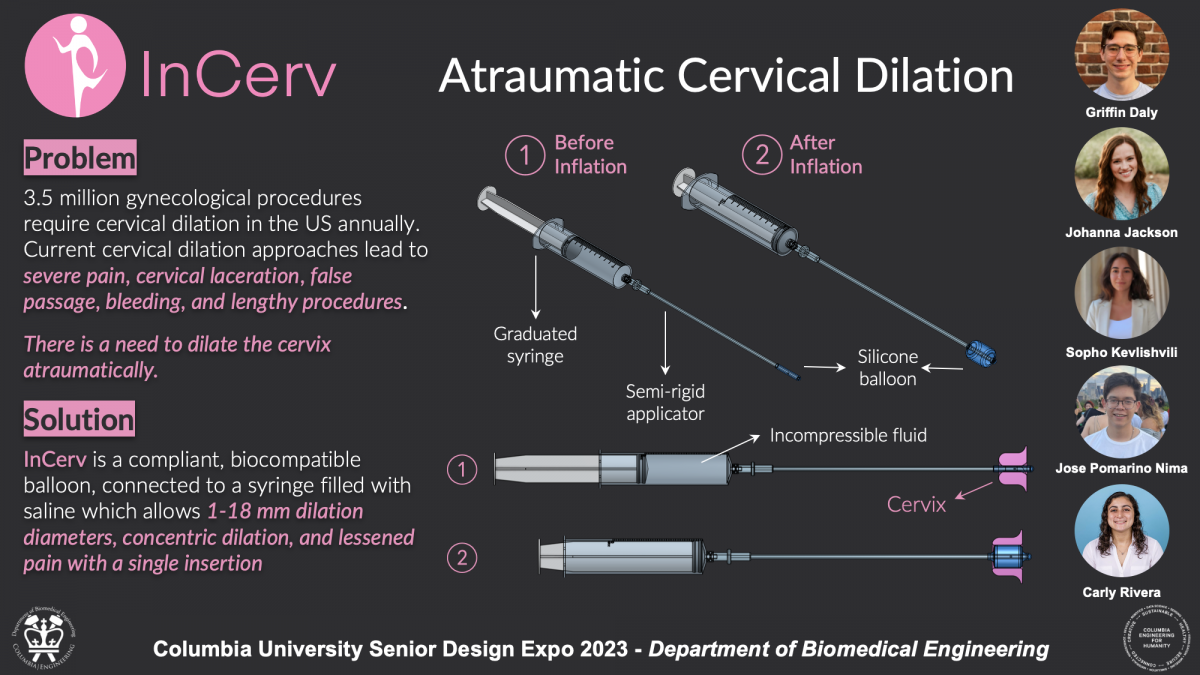
connectiV: Runner Up, BME 2023 Senior Design Award
Design Team Members: Helena Cirne, Anjali Santhanam, Kiara Robichaud, Caitlyn Limanto, Elvin Canseco
Within the NICU (Neonatal Intensive Care Unit), most neonates require intravenous (IV) therapy. Full-term infants receive up to 100-140 mL/kg/day, yielding an administration of 10-20 mL/hr. However, the rates can get as low as 0.1 mL/hr for concentrated drugs. Multiple inputs must be connected to a singular vascular access device, increasing variability in flow rate and risk of backflow due to flow interactions between several input sources at connection points. Improper administration of medication can cause serious adverse events such as abnormal blood pressure, anxiety from a loss of sedation, and increased pain. Thus, there is a need to reduce flow inconsistencies within NICU tubing connection ports while monitoring fluid flow for precise drug dosing in neonatal patients. To address these shortcomings in neonatal IV therapies, we have created a two-part system. The first component replaces existing connection ports with 3D-printed, medically safe, sterile millifluidic chips. The millifluidic chip increases flow rate consistency and reduces negative flow interactions to ensure more accurate drug delivery. This works in conjunction with an external, photoresistor-based flow detection system that facilitates hands-off monitoring. This device will be capable of alerting health providers to potential disruptions of flow. connectiV works to minimize the deficiencies in the current technology used in the NICU by improving the system of IV drug delivery.
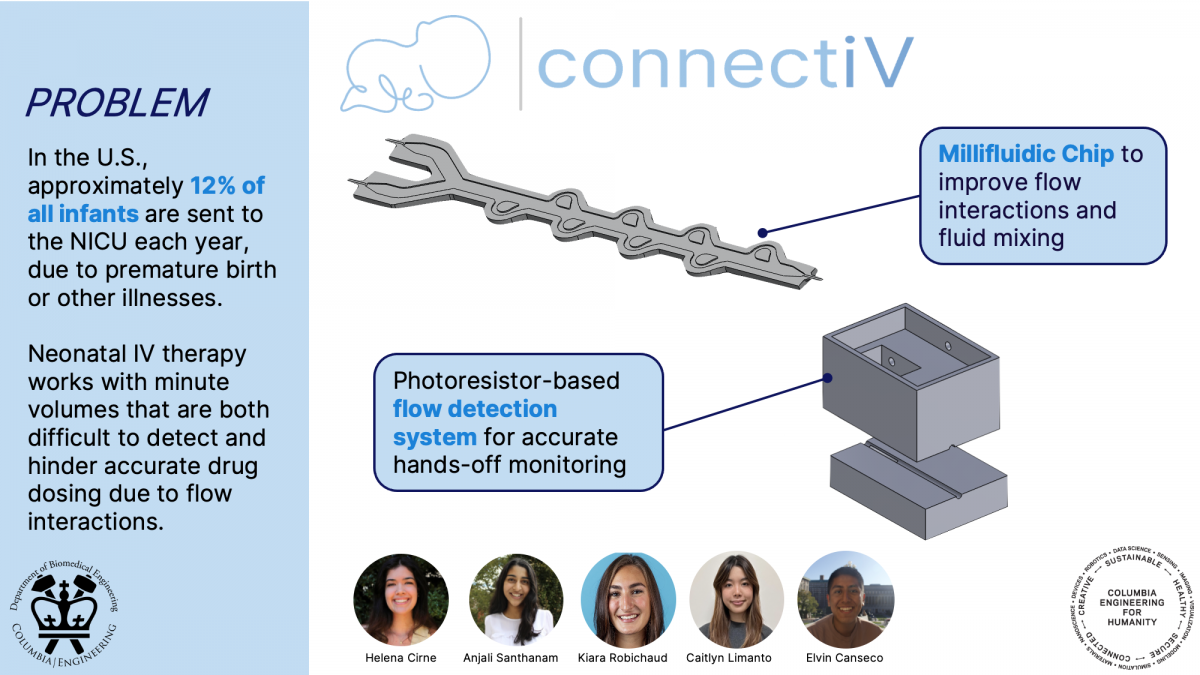
Resonance: Runner Up, BME 2023 Senior Design Award
Design Team Members: Hannah Matin, Matthew Lange, Skylar Li, Leo Campos, Julia Zhao, Athena Tsu
Mucus build-up in the airways is a major issue for many patients with pulmonary diseases; for example, 50% of COPD patients have mucus hypersecretion, which correlates with a 3.5 times greater risk of dying. Oscillating positive expiratory pressure (OPEP) is commonly used to break up airway mucus for easier expulsion. Such devices oscillate to induce vibrations of resonant frequencies with the patient’s airway cilia, thus mechanically agitating the mucus and promoting its movement up the airways. However, current OPEP devices have several issues. Their patient effort requirements result in contraindications that exclude certain populations, and variability between devices makes it difficult to predict efficacy. In addition, depending on the OPEP device utilized, patient utilization is complicated by uninformative controls and precise handling. Thus, there exists a need for improved treatment for patients who experience mucus build-up in the airways. To address these issues with current OPEP devices, our device leverages fundamental principles of OPEP therapeutic parameters with electronic capabilities for optimized performance across a wider range of patients. Using a fully automated solenoid-based oscillation mechanism that is adjustable by the patient for their specific needs, we not only provide transparent therapeutic measures of frequency, but streamlined controls and reduced patient effort necessary for therapeutic effect.
